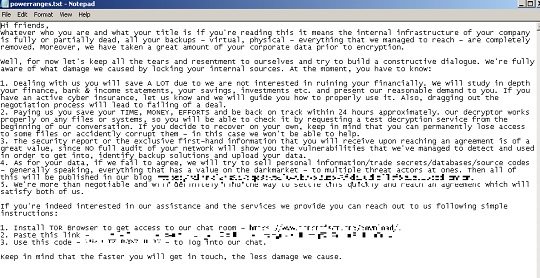Ransom.Win64.MEGAZORD.THHBIBC
Ransom:Win32/Megazord.A!dha (MICROSOFT),
Windows


Threat Type: Ransomware
Destructiveness: No
Encrypted:
In the wild: Yes
OVERVIEW
This Ransomware arrives on a system as a file dropped by other malware or as a file downloaded unknowingly by users when visiting malicious sites.
It drops files as ransom note.
TECHNICAL DETAILS
1,475,584 bytes
EXE
No
29 Aug 2023
Disables AV, Encrypts files, Terminates processes
Arrival Details
This Ransomware arrives on a system as a file dropped by other malware or as a file downloaded unknowingly by users when visiting malicious sites.
Installation
This Ransomware adds the following processes:
- cmd.exe /c powershell-command \"Get-VM | Stop-VM -Force\"/C"
Process Termination
This Ransomware terminates the following services if found on the affected system:
- MSSQL$ISARS
- MSSQL$MSFW
- SQLAgent$ISARS
- SQLAgent$MSFW
- SQLBrowser
- ReportServer$ISARS
- SQLWriter
- WinDefend
- mr2kserv
- MSExchangeADTopology
- MSExchangeFBA
- MSExchangeIS
- MSExchangeSA
- ShadowProtectSvc
- SPAdminV4
- SPTimerV4
- SPTraceV4
- SPUserCodeV4
- SPWriterV4
- SPSearch4
- MSSQLServerADHelper100
- IISADMIN
- firebirdguardiandefaultinstance
- ibmiasrw
- QBCFMonitorService
- QBVSS
- QBPOSDBServiceV12
- IBM Domino Server
- IBM Domino Diagnostics
- Simply Accounting Database Connection Manager
- QuickBooks
It terminates the following processes if found running in the affected system's memory:
- veeam*
- chrome*
- iexplore*
- firefox*
- outlook*
- excel*
- taskmgr*
- tasklist*
- Ntrtscan*
- ds_monitor*
- Notifier*
- putty*
- ssh*
- TmListen*
- iVPAgent*
- CNTAoSMgr*
- IBM*
- bes10*
- black*
- robo*
- copy*
- store.exe
- sql*
- vee*
- wrsa*
- wrsa.exe
- postg*
- sage*
- mysql*
Other Details
This Ransomware accepts the following parameters:
- --path
: Start path - --id
: Build ID - --threads
: Number of threads (1-1000). Default value is the number of logical CPU cores - --ep
: Encryption percentage. Default 15% - --logs
: Print logs. Valid values for: trace, debug, error, info, warn. Default: off - -h, --help : Show help
Ransomware Routine
This Ransomware appends the following extension to the file name of the encrypted files:
- .powerranges
It drops the following file(s) as ransom note:
- {Encrypted directory}\powerranges.txt

SOLUTION
9.800
18.664.02
29 Aug 2023
18.665.00
30 Aug 2023
Step 1
Before doing any scans, Windows 7, Windows 8, Windows 8.1, and Windows 10 users must disable System Restore to allow full scanning of their computers.
Step 2
Note that not all files, folders, and registry keys and entries are installed on your computer during this malware's/spyware's/grayware's execution. This may be due to incomplete installation or other operating system conditions. If you do not find the same files/folders/registry information, please proceed to the next step.
Step 3
Identify and terminate files detected as Ransom.Win64.MEGAZORD.THHBIBC
- Windows Task Manager may not display all running processes. In this case, please use a third-party process viewer, preferably Process Explorer, to terminate the malware/grayware/spyware file. You may download the said tool here.
- If the detected file is displayed in either Windows Task Manager or Process Explorer but you cannot delete it, restart your computer in safe mode. To do this, refer to this link for the complete steps.
- If the detected file is not displayed in either Windows Task Manager or Process Explorer, continue doing the next steps.
Step 4
Search and delete these files
- {Encrypted directory}\powerranges.txt
Step 5
Scan your computer with your Trend Micro product to delete files detected as Ransom.Win64.MEGAZORD.THHBIBC. If the detected files have already been cleaned, deleted, or quarantined by your Trend Micro product, no further step is required. You may opt to simply delete the quarantined files. Please check the following Trend Micro Support pages for more information:
Step 6
Restore encrypted files from backup.
Did this description help? Tell us how we did.

